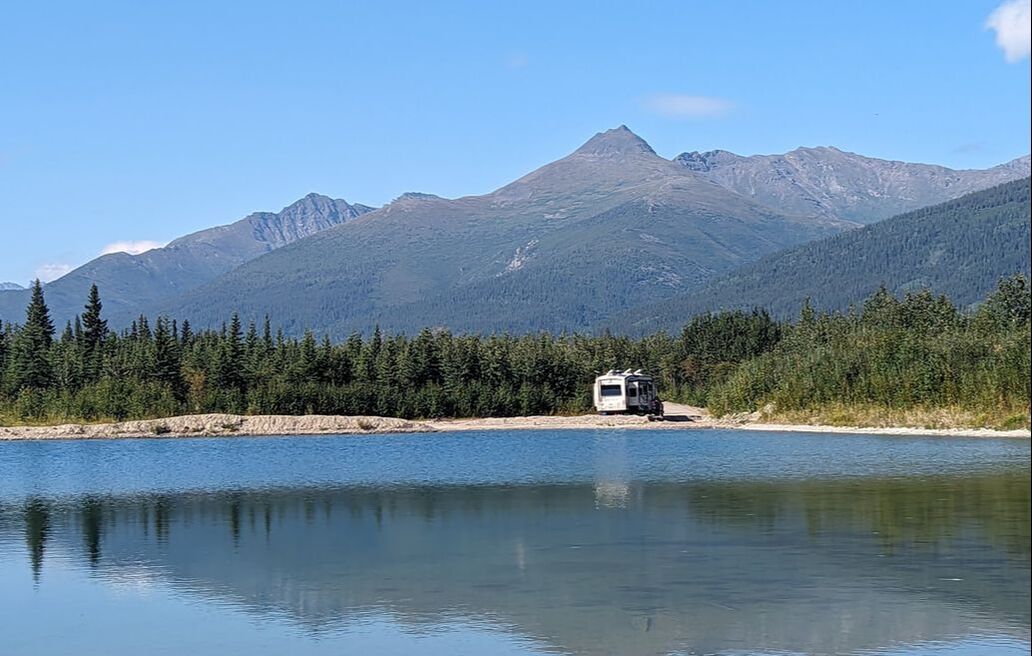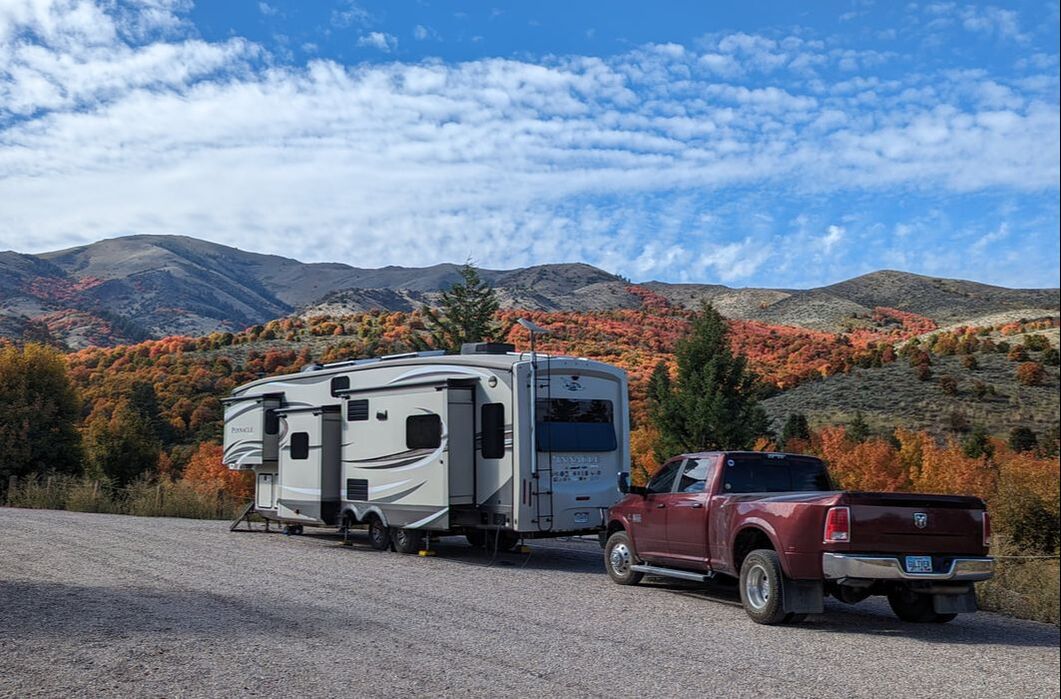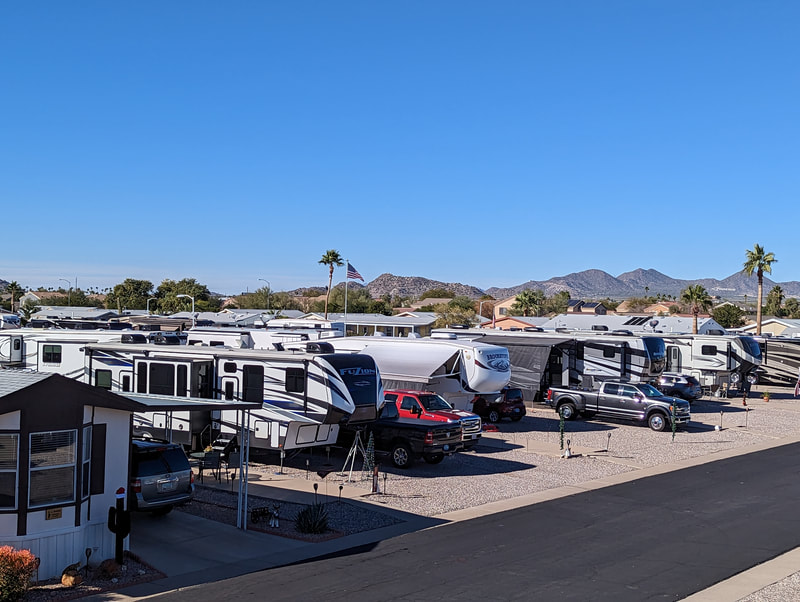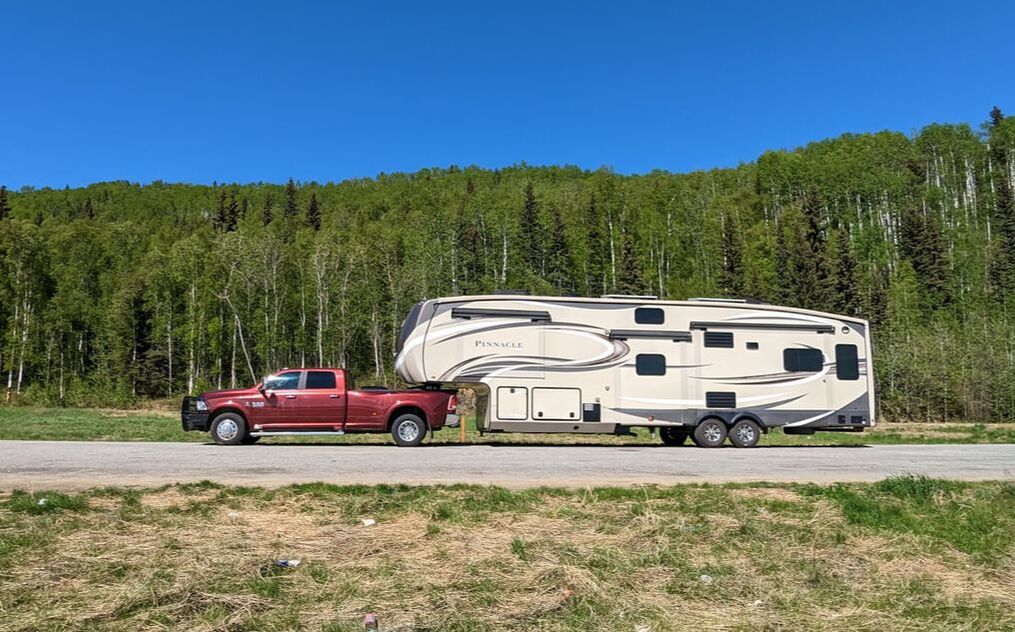|
In each of our first three years of full-time RV travel, we towed Tagalong less than 8,000 miles. A more adventurous trip to Alaska in our fourth year on the road scored Tagalong 9,302 miles. Gulliver earned additional mileage from our explorations while disconnected from the trailer, including an ambitious 1,015-mile round-trip journey to the Arctic Ocean. We kept our travel days relatively short, averaging an enjoyable 202 miles per stint, from expansive desert to amazing red rocks to snow-capped mountains to lake and river views. Our longest trek, not counting the Arctic Ocean adventure, spanned 500 miles, from Valley of Fire in Overton, Nevada, to Twin Falls, Idaho. Our record 46 stops (due to multiple single-night stays both ways on the Alaska Highway) took us through four states we were able to add to our RV map — Washington, Idaho, Montana, and Alaska — plus three Canadian provinces: British Columbia, Alberta, and Yukon. We stayed at only eight campgrounds with some form of hookups and at another four with no hookups. We counted those that lacked energy connections among our 14 boondocking sites. We also overnighted in 14 parking lots and moochdocked at seven locations. Here are our favorite stops in our fourth year of RV travel: Favorite Campground The eight campgrounds we visited offered convenience. I remember pulling into the Sourdough Campground and Cafe in Tok, Alaska, and taking advantage of the electricity to vacuum the inside of the trailer after the long haul on the Alaska Highway. We did the same thing upon arrival at Fool Hollow Lake Campground in Show Low, Arizona, after a couple of weeks of boondocking. Many people frequent campgrounds to get away from those conveniences. We go there to enjoy them. Our two favorite campgrounds for the year were both in Canada. The Kimberley Riverside Campground in British Columbia, as its name implies, sits near a roaring river. We enjoyed spying on deer from our windows and walking along the water to explore our surroundings. More than Kimberley, we liked Brewers Campground, situated close to a beach in Lacombe County, Alberta, despite the unwanted RV guest that came with it. We visited this location in the fall and relished the changing foliage colors and crunching leaves under our feet. Because we were there after the busy season, we found the place incredibly serene. Favorite Boondocking Stay Our boondocking stays for the year ran the gamut, from desert dwelling outside Las Vegas to hanging out in a tree-shrouded dry campground next to some natural hot springs to backing up our trailer to overlook Cook Inlet and Port Valdez in Alaska to camping against a backdrop of red maple trees. It’s nice to be able to live off the grid and rely on solar and generator power to supply our energy needs. It allows us to get into some pretty quiet and remote areas. Narrowing down our favorite boondocking spot was a tough choice between Gravel Lake in Mentasta Lake, Alaska, and Goodenough Creek Campground in McCammon, Idaho. We spent three wonderfully relaxing weeks at Gravel Lake, where we appreciated an occasional moose wading into the water, trumpeter swans skiing to a stop on the manmade lake, and quiet solitude interrupted infrequently by a camper passing through. Despite that peaceful and much-needed stop after a very busy and ambitious Alaska adventure, we named Goodenough Creek Campground our favorite boondocking stay because of the incredible beauty of vibrant red maple leaves that surrounded us there. I owe the benefit of viewing the amazing scenery at Goodenough Creek to my free-spirited husband, who’s successfully worn down my rigid edges over the years to make it possible for me to move locations within an hour of his suggestion. It used to take me many days to think about a decision of that magnitude, and by then, the opportunity would have evaporated. Favorite Overnight Stop On the way to Alaska and back, we mainly boondocked at turnouts along the highway. In addition to those overnight stops for the year, we stayed at a few truck stops, a museum, a mall, and a grocery store — all with permission. As you can imagine, some of those stays were more scenic than others. Kluane Lake Viewpoint Parking in Destruction Bay, Yukon, made the top overnight spot in our book. We visited the site on our way to Alaska, when ice covered much of the lake, and again on our way back, when the mountains lacked snow. We found both times to be beautiful and refreshing. Spotting the northern lights from this location made it that much more special. Favorite Moochdocking Spot We’re pretty spoiled in that we’re blessed to be able to stay with family and friends across the continent during our travels. We spent two weeks with cousins near Fairbanks, Alaska, another few weeks with cousins in Willow, Alaska, and a week with an aunt and uncle in Palmer, Alaska.
We also took advantage of a week with friends near Nampa, Idaho, a night with friends in Calgary, Alberta, a night at a Boondockers Welcome host in Carvel, Alberta, and a week at the Museum of Mountain Flying in Missoula, Montana. We always appreciate our moochdocking stays and find it difficult to rank them. Each offers something different and memorable. If we had to choose our favorite for the year, it would be a toss-up between Willow, Alaska, and Nampa, Idaho. In Willow, we parked in such a way that our rig overlooked a lake and gave us inspiring views of the water and the birds and beavers that call it home. Finding campgrounds costly and boondocking options minimal in Nampa, we stored Tagalong for a week and stayed in the home of friends Kerry and Bev — and their little dog, Kona, whom we fell in love with. Favorite State Without a doubt, our favorite state of the year was Alaska. We found our time there fun, adventurous, and tranquil. We enjoyed catching up with family there and being able to get up close and personal to God’s amazing creation. We’re already planning another trip back. You might also like 5 Favorite Things About Our Summer RV Trip to Alaska.
3 Comments
RV lifestyles come in two major forms: seasonal full-time RV living and life on the road. The first can include a stationary setup in one location for fall and winter or winter and spring and a stationary setup in another location for the other two seasons. We’ve found that by combining the two types of RV lifestyles, with seven months on the road and five months in a single location, we get the best of both worlds. Nomad on the Move Most of the year, we travel the country to see destinations and visit loved ones along the way. As Bob likes to say, “Throw a dart at a map of the U.S., and we might be there.” He’s right, as our itinerary changes every year — sometimes on a monthly or daily basis. That’s one of the things we relish about RV life: the flexibility. If friends and family at an upcoming stop have to leave town suddenly, we can quickly change plans and reroute our course. If our planned travel day looks iffy because of rain and storms, we can pivot and stay put for a few more days or even a week. In this nomadic lifestyle, we typically move to a new location every week or two. In doing so, it becomes second nature for us to pack and close the trailer, hook it up to Gulliver, spend hours on the road, park, and set up camp. Lather, rinse, repeat. While in a location, we try to make a point to investigate our surroundings and get a feel for the area. That’s part of the adventure. Each stop holds a sense of intrigue and mystery. We immerse ourselves in the locality and try to find off-the-beaten-path things to do — as well as some popular things to do, such as visiting national and state parks. Seasonal Resident When we’re not moving every week, we live a completely different life. Bob equates it to taking off one jacket and putting on another, much like Mr. Rogers did. With months in one location and a reprieve from regularly packing and setting up the trailer, we enjoy more leisure and get comfortable in our home. We feel freer to leave things out, such as my puzzle table and in-process projects, and we notice bare spots that could use decoration. This can lead to accumulation creep, something we have to guard against. While stationary, we tend to live the way we would if we had a sticks-and-bricks home. Bob goes to the Commemorative Air Force three days a week to put his aircraft mechanic degree to work on WWII bombers, and I get into my daily work routine. We habitually frequent the grocery store, and our calendar fills up with activities and get-togethers. Being static also gives us ample time to address maintenance, issues, and needed upgrades on our truck and trailer. The Human Perspective Because we have traveling to look forward to when we’re stationary and an end of travel in sight when we grow weary of being on the road, we really do have the best of both worlds. It keeps life exciting and fun — as does meeting amazing people, which happens in both RV lifestyles. I think of the trucker we crossed paths with in Michigan, who graciously gave us diesel exhaust fluid (DEF) at a rest area when we were about to run out. Without that in our truck, it would have slowed to a painful 5 mph.
The trucker wouldn’t take money in exchange for the DEF, so I suggested we pay it forward. A few minutes later, another trucker pulled into the rest area with a flat tire and no way to fix it to move on. We offered the use of our 80-pound air compressor, happy to help. While we were assisting this second trucker, another RVer pulled up and asked if we needed help. We also met a young couple early in their RV life and were able to share some tips and advice. At a boondocking spot, fellow RVers gave us guidance based on their RVing experience. And another RVer lent us a water hose to add to ours so we could fill our water tank without moving our trailer. Stationary RVers are just as friendly and welcoming. We regularly exchange greetings and conversations with our seasonal neighbors. And they’re always quick to give us a hand if we need it, just as we’re eager to help them if we can. The RV community is one of people helping people. We’re thankful to be part of it. You might also like Confessions of a Full-Time RVer. The red rocks of Moab, Utah, draw upward of 1.8 million visitors annually to take in their beauty. We had passed through once, in awe of the vibrant scenery around us — and of the number of people thronging the road. Despite the crowds, the city of 5,200 left us with a desire to return when we had more time to explore. The big attraction in Moab is Arches National Park, which beckons tourists to navigate its 76,519 acres in search of more than 2,000 sandstone arches. A drive through the park provides glimpses of a handful of the natural structures. Seeing the others requires hikes of varying lengths. In a 3.5-hour span with multiple stops, we lay eyes on about a dozen of the magnificent rock formations, in addition to petrified sand dunes and other captivating displays. The mesmerizing beauty left us in awe and hearkened back to a bygone era, documented at one point by petroglyphs on a rock. One thing we noticed missing from this national park that we’d encountered at others was wildlife — although Gulliver did get a not-so-secret admirer. Going on a Dino Hunt A lesser-known noteworthy aspect of Moab is its dinosaur history. In addition to a couple of museums, the city offers three dinosaur track sites, with imprints of massive wildlife of old. Mill Canyon Dinosaur Tracksite showcases fossilized dinosaur footprints preserved in limestone, protected by a boardwalk around the “stomping ground.” According to plaques at the site, algae covered the shallow lake, capturing the dinosaurs’ tracks before the water, mud, and algae dried up and hardened into limestone, with the prints intact. We saw 10 different kinds of tracks, representing dinos of varying sizes, from velociraptor up to brontosaurus. Thinking about the gargantuan creatures roaming the area made us feel small and gave us a completely different perspective on our surroundings. Wild Pterodactyl Chase Wanting to see a more impressive display, we headed to Copper Ridge Dinosaur Trackways and set out on Dino Flow Trail, which we believed to be 1.5 miles. Nearly 3 miles later, it had become quite evident I had taken Bob on a wild pterodactyl chase. After the trail meandered over multiple rises and around numerous bends, no track site came into view. We decided to cut our losses and turn around. Returning to the parking area, the actual location of the imprints became apparent. We had read that this location offered two areas of tracks. We didn't realize they both started at the same trail. Reviews said the site closest to the beginning of the Copper Mine Ridge trailhead wasn’t too impressive. The more alluring site lay 1.5 miles up the trail. Having already put 5 miles under our belts, we forwent the latter and settled for the first, finding it plenty awe-inspiring. We could actually stand in some of the enormous footprints and imagine the weight and size of the behemoths that made them. Picking a Bone Our dino hunt didn’t end there. The Moab area also offers a place to see fossilized dinosaur bones intact in hardened rocks, not in a museum. We headed to the Mill Canyon Dinosaur Bone Trail. A sign warning of soft sand and recommending only four-wheel-drive vehicles beyond that point stopped us in our tracks. Since Gulliver isn’t four-wheel-drive, we didn’t want to risk getting stuck in the soft sand like we had done in Traverse City, Michigan. It seemed we’d have to end our dino hunt. I reread reviews about the dinosaur bone trail and learned we weren’t the only ones who didn’t want to drive beyond the sign. Others had parked nearby and walked the half mile to the trailhead. We decided the additional 1-mile round-trip trek would be worth it. The walk through soft sand and over rocks confirmed we had made the right decision in not taking Gulliver down the path. Arriving at the Mill Canyon Dinosaur Bone Trail, we noticed paths in three different directions. Where were we to find the bones? We opted for the trail just past a visitor sign-in podium and encountered a plaque a few strides later. We had chosen wisely. Hardened Evidence Signs like the first were sprinkled along the trail, describing what to find in each area, with detailed information about where to look. Had it not been for the plaques, we wouldn’t have known the rock color variances we observed as we walked along a ridge were actually bones from giants that once walked the land. The fossils looked darker than the rocks in which they were wedged. More amazingly, they felt different from the rock surrounding them, lighter in weight like calcified bones. We saw and touched foot, toe, arm, leg, rib, and spine skeletal parts from sauropods — the generic name for plant-eating dinosaurs with long necks and tails that could span 20 to 112 feet in length. I found it hard to believe that a creature so large could survive on plants alone. We also observed bones from a meat-eating allosaurus with a max length of about 30 feet.
Playing paleontologist made our Jurassic adventure a fun and memorable experience. It also gave us a greater appreciation for prehistoric times, when colossal animals roamed the vast Earth. You might also like Exploring Valley of Fire State Park in Nevada. |
AuthorThis is the travel blog of full-time RVers Bob and Lana Gates and our truck, Gulliver, and fifth wheel, Tagalong. Categories
All
Archives
July 2024
|


















 RSS Feed
RSS Feed